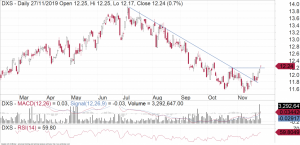Real Estate Investment Trusts (REITs) have performed well during 2019. With some looking quite expensive here, Dexus (ASX:DXS) is a stock which not only looks to be reasonable value here, but has a trading profile that indicates further upside.
About Dexus
Dexus is an internally-managed ASX-listed stapled REIT that owns, manages and develops real estate in Australia. Its focus is principally in the Office (of which 88% is classified as ‘Prime Grade’ office space) and Industrial sectors, as well as “alternative” sectors such as Healthcare and some exposure to Retail within its external funds business.
The business strategy revolves around leveraging off two key long-term growth themes. These are:
i) Increased urbanisation in and around key economic and transport hubs, and
ii) Increased demand for real assets consistent with growth in pension capital flows.
The Company derives income from three main sources, namely rental income from directly-held real estate assets, fee income from the management of its external funds platform, and trading profits from the sale of development assets.
Key Fundamental Drivers
1. The outlook for office markets in Sydney and Melbourne is a key driver of investor sentiment towards DXS. The Company has a direct office portfolio of 46 properties with a book value of $13.2b as at 30 June 2019. While the key performance metrics for the Company’s office portfolio (i.e. high occupancy; Like for Like income growth continuing to trend higher; average incentives trending lower; and meaningful compression in cap rates), the medium-term outlook for office markets in Sydney and Melbourne is more challenging. In particular, concerns about a likely moderation in rental growth in 2020-22 as new supply come onto the market has been one reason for the weakness in the share price since the announcement of the FY19 results.
In our view, it appears that investors are factoring in a quicker downturn in office market conditions. While there is validity to market concerns about a medium-term increase in office supply tempering income growth, we consider that Office market conditions in Sydney and Melbourne are likely to remain favourable over the course of FY20 and FY21. In turn, this is likely to support office income growth especially given the Sydney office market remains under-rented. Currently >70% of lease expiries in FY20 are in Sydney and ~50% of FY21 expiries are in Sydney.
2. DXS’ premium to NTA is no longer demanding. DXS is currently trading on a 17% premium to its NTA of $10.48 per share as at 30 June 2019, which compares to a 25% premium at its recent peak. The current premium is not demanding in comparison to its diversified REIT peers, GPT, MGR and SGP, which are trading at premiums to NTA of 9%, 34% and 25% (based on closing prices at the time of writing), respectively.
Further, the potential for NTA growth is supported by revaluations and further cap rate compression. The Company expects at least 25 basis points of cap rate compression for quality industrial properties over the next 12 months. Assuming 25 basis points cap rate compression across the entire portfolio potentially increases the NTA from $11.00 to $11.20 per share.
3. DXS has shown an ability to convert its strong development pipeline into a consistent earnings stream. The development pipeline should continue to grow, in light of the low cost of debt improving access to capital. In particular, the cost of debt in FY20 is expected to be ~3.5%, in comparison to 4.0% in FY19.
4. The level of gearing on the balance sheet is low, at 24%. This is below its longer-term target of 30-40% as well as the covenant gearing level of <55%. The low gearing level, coupled with $950m of available liquidity, leaves DXS well placed to fund its committed development CAPEX requirement of $600m and/or potential acquisitions. In the absence of any acquisitions, we expect continued asset sales from the Trading Profits business* will help maintain low gearing levels.
Fundamental View
Based on the above factors, we consider that Dexus is presently an investment worth considering. Further, the current distribution yield of 4.3%, growing sustainably at ~5%, should become more attractive to income-focused investors while office market conditions remain supportive.
Charting View
DXS had been in a downtrend since its peak in early July where it had been making lower highs and lower lows. In the last several days though, it has started to show the first signs that it is trying to break that downtrend. With it now pushing past the previous high to make a “higher high” (horizontal line) , it has made us more comfortable that it is ready to head higher again and possibly resume the longer term uptrend.

* The strategy of the Trading Profits business unit is to refurbish or re-position an asset, re-lease it, and sell it. Since FY12, DXS has sold 14 properties, realising over $300m of after-tax profits. The Company is targeting $35-40m of after-tax profits in FY20 and the Company has already secured profit from the sale of two assets, which have significantly de-risked trading profits in FY20/21.




